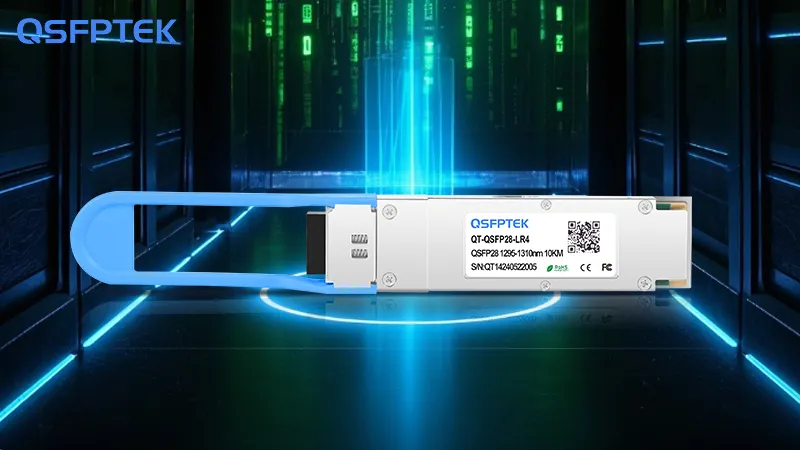As global data traffic continues to surge, modern data centers face increasing demands for high-speed, stable, and scalable long-distance interconnection. The ability to efficiently link multiple data center facilities—whether within a single metropolitan area or across regions—is crucial for ensuring seamless data transmission, redundancy, and business continuity.
To meet these demands, data centers rely on 100G optical transceivers, among which the QSFP28 100GBASE-LR4 module stands out as an ideal solution for long-range interconnects. With a transmission range of up to 10km over single-mode fiber (SMF), 100GBASE-LR4 enables cost-effective, high-performance networking. This article explores the technical advantages of 100GBASE-LR4, its role in data center interconnectivity, and best practices for deployment.
Overview of QSFP28 100GBASE-LR4 Optical Module
The QSFP28 100GBASE-LR4 transceiver is designed to transmit 100Gbps over single-mode fiber (SMF). It follows the IEEE 802.3ba standard and operates using 4×25Gbps wavelength division multiplexing (WDM) technology.
Key Features of 100GBASE-LR4
Transmission distance: Up to 10km over single-mode fiber
Connector type: LC duplex for bidirectional transmission
Wavelengths: Four LAN-WDM channels (1295nm, 1300nm, 1305nm, 1310nm)
Power consumption: Typically < 4W, making it energy efficient
Modulation format: NRZ (Non-Return-to-Zero) signaling
How It Works?
The 100GBASE-LR4 module splits electrical signals into four optical lanes, each operating at 25Gbps. These four optical signals are multiplexed onto a single fiber for transmission. On the receiving side, the module demultiplexes the signal back into four electrical signals. This wavelength-division multiplexing (WDM) method allows efficient data transfer over long distances without requiring additional fibers.
The Need for Long-Distance Interconnection in Data Centers
Modern data centers are no longer isolated entities. Instead, they operate as distributed ecosystems with multiple sites connected for redundancy, workload balancing, and real-time data processing. Long-distance interconnectivity is vital for various applications, including:
Cloud computing: Large-scale cloud providers need high-speed links between geographically distributed data centers.
Disaster recovery: Ensuring seamless data synchronization between primary and backup sites.
Content delivery networks (CDNs): Streaming platforms and online services rely on fast data replication across different locations.
Challenges of Long-Distance Data Center Interconnects
While interconnecting data centers offers numerous benefits, it also presents challenges:
Signal attenuation: Over long distances, optical signals weaken, requiring modules with adequate power budgets.
Latency concerns: Data centers must minimize transmission latency to optimize application performance.
Infrastructure costs: Deploying long-distance optical links often involves significant upfront investment in fiber cabling and transceivers.
By adopting 100GBASE-LR4, data centers can overcome these challenges and establish high-bandwidth, cost-effective long-distance interconnects.
Why Choose 100GBASE-LR4 for Data Center Interconnection?
Extended Transmission Distance
Compared to short-range modules like 100GBASE-SR4, which only supports up to 100m over multimode fiber (MMF), 100GBASE-LR4 can reach 10km over single-mode fiber (SMF). This makes it an excellent choice for connecting multiple data center buildings within a metropolitan area.
Efficient Fiber Utilization
100GBASE-LR4 utilizes LC duplex connectors, allowing it to transmit 100Gbps using only two fibers. In contrast, 100GBASE-PSM4 requires eight fibers, leading to higher fiber deployment costs. Since many data centers already use single-mode fiber for long-haul connectivity, adopting 100GBASE-LR4 is both practical and cost-effective.
Compatibility and Reliability
As a standardized solution under IEEE 802.3ba, 100GBASE-LR4 ensures interoperability with a wide range of networking equipment, including switches and routers from major vendors. This reduces deployment risks and simplifies network management.
Best Practices for Deploying 100GBASE-LR4 in Data Centers
To maximize the performance and cost-effectiveness of 100GBASE-LR4, data centers should adopt the following best practices:
Optimize Fiber Infrastructure
Use high-quality single-mode fiber to minimize optical loss and ensure optimal signal transmission.
Ensure proper fiber routing and cable management to prevent excessive bending and stress, which can degrade performance.
Monitor optical power budgets to avoid signal degradation due to excessive loss or dispersion.
Ensure Equipment Compatibility
Verify that network switches, routers, and servers support 100GBASE-LR4 before deployment.
Perform pre-deployment compatibility testing to identify any interoperability issues.
Regularly update firmware on networking equipment to maintain compatibility and optimize performance.
Cost Optimization Strategies
Consider third-party compatible 100GBASE-LR4 transceivers: Many third-party vendors offer high-quality, cost-effective alternatives to OEM modules without compromising performance.
Adopt a phased migration strategy: Instead of a sudden transition, data centers can gradually upgrade from 10G/40G to 100G, balancing cost and scalability.
Regular fiber maintenance: Cleaning fiber connectors and conducting periodic inspections can prevent performance degradation and reduce long-term replacement costs.
Conclusion
The QSFP28 100GBASE-LR4 optical module is a proven, reliable, and cost-effective solution for long-distance data center interconnection. With its 10km transmission range, efficient use of single-mode fiber, and standardized compatibility, it plays a crucial role in modern data center architectures.
By implementing best practices in fiber management, equipment compatibility, and cost optimization, organizations can maximize network efficiency and future-proof their infrastructure for evolving demands.
As data traffic continues to grow, 100GBASE-LR4 remains a key enabler of high-speed, scalable data center interconnects, bridging the gap between today’s networking needs and future innovations.



